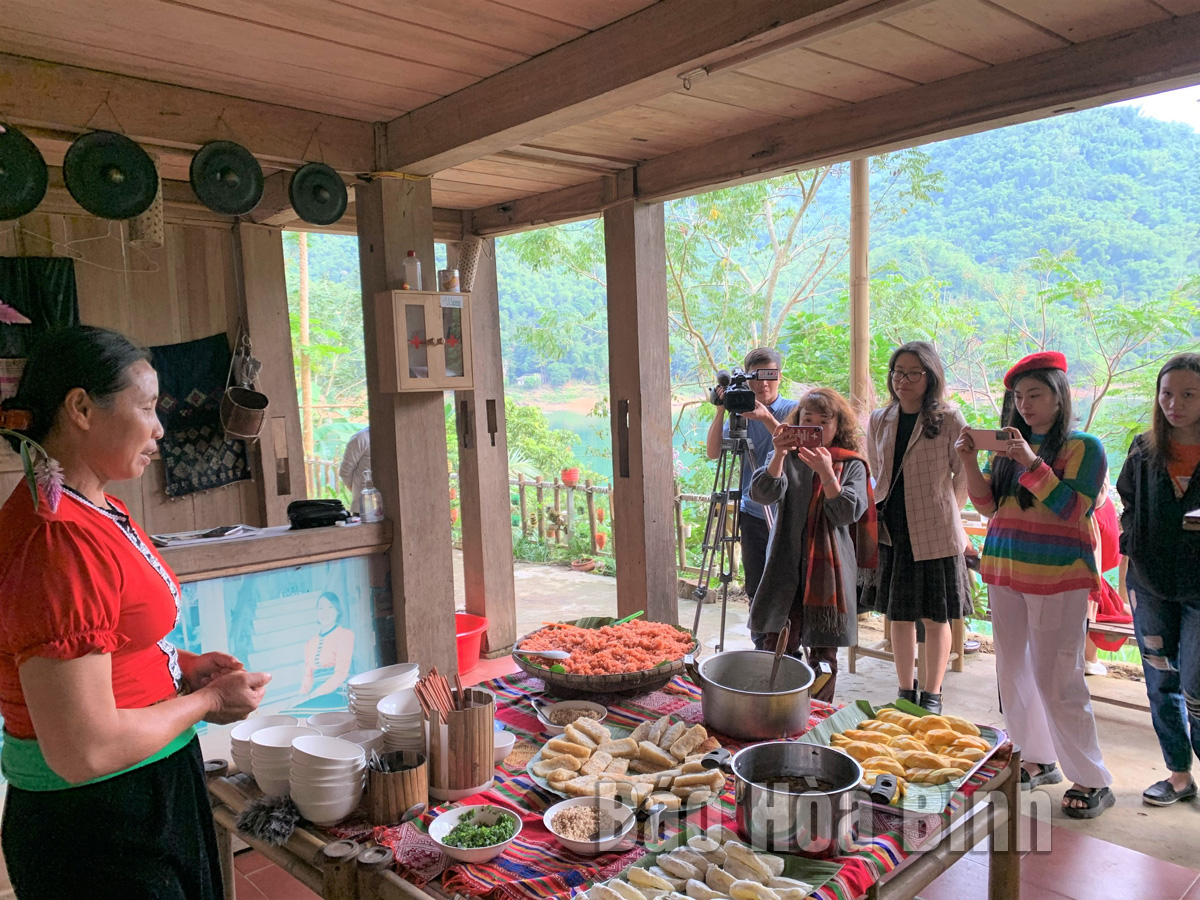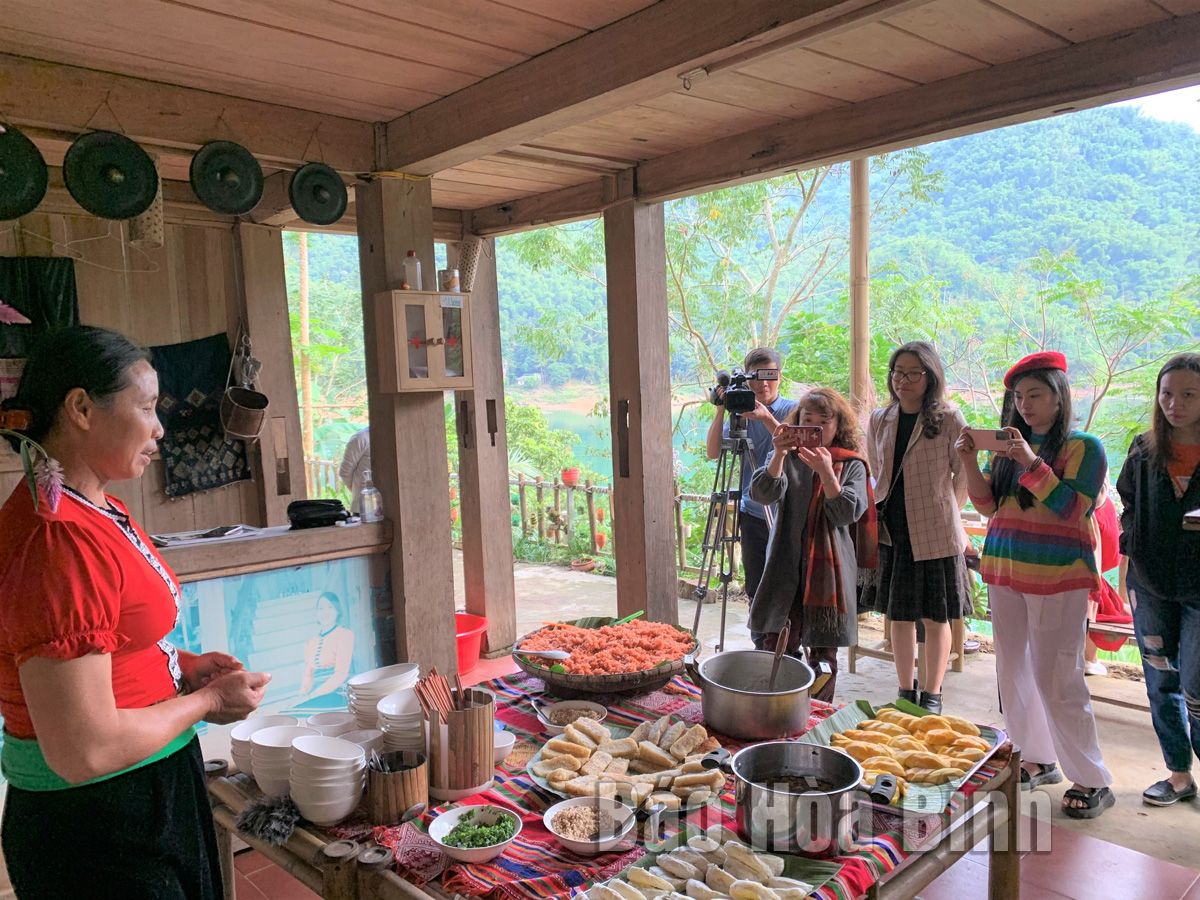



Muong ethnic people in Tien Phong commune (Da Bac) are introducing the local cuisine to the famtrip group in the province's program for the tourism propaganda and promotion.
Having the opportunity to visit the community tourism villages in Cao Phong, Tan Lac and Da Bac districts, visitors will enjoy the typical cuisine of the ethnic groups in the Northwest in general and Hoa Binh in particular. Ms. Dinh Thi Yeu, a household providing accommodation services at Da Bia community tourism site, Tien Phong commune (Da Bac) says: Welcoming visitors to the village, the people often prepare sticky rice, the on-leave -tray dishes and Can wine. To have the fragrant and sticky rice, the families often soak the rice thoroughly and keep the food in the wooden pot to keep its sweetness. While eating, visitors hold the rice and the seeds stick together, making it more flexible and delicious. With on-leave -tray dishes, the main ingredient is made from pork, it must be a free-range pig with the firm, aromatic, low-fat meat, so it is not fed-up. Displayed on the fresh banana leaves, the on-leave -tray dishes include many dishes such as: The thinly sliced boiled meat, the grilled meat, the inside pig organs, the sticky rice, banana soup... the on-leave -tray dishes are also the most typical cuisine of Muong ethnic people, which always look forward to being introduced when visitors have the opportunity to experience the lake tourism.
Visiting and traveling on the lake, visitors also do not forget to enjoy the fish and shrimp cuisine of Da River. During a cozy meal in the stilt housses, the families in Ngoi hamlet, Suoi Hoa commune (Tan Lac) often treat visitors with the delicious grilled fish, the fresh steamed fish and the sour fish soup with a cool and nutritious taste. Mr. Hoang Van Khanh, a Hanoi visitor says: After a journey of visiting the beautiful landscapes, learning about the customs and habits of the village, our group was welcomed with a thoughtful and warm dinner. With the clean and fresh ingredients and skillful hands of the owner, we can only admire the attractiveness of the fish specialties of Da river.
In addition to the on-leave -tray dishes and the fish of Da River, the cuisine of the lake region also has chicken cooked with sour bamboo shoots and Doi seeds, the ingredients from the chicken, raising on the hill, bamboo shoots and very delicious seeds. Ms. Bui Thuy Chieu, a resident from Mo village, Binh Thanh commune (Cao Phong) says: Chicken cooked with sour bamboo shoots and Doi seeds is a dish only found in Muong areas in Hoa Binh and it has become a favorite specialty of tourists. The preparation of this dish is quite simple. The clean chicken is cut into bite-sized pieces, then it is put in the pot to mix with sour bamboo shoots thoroughly so that the meat blends well with the bamboo shoots, then add enough water and cook it for about half an hour. Before scooping out into a bowl, bake a few Doi seeds, pound them and sprinkle and stir them. When eating, the piece of sour bamboo shoots is well-done and soft, it is very rich but not greasy. Another dish that is often present in the meals of the people within the lake area is pomelo leaf rolls made from pork. Accordingly, the belly pork is sliced, marinated with fish sauce and onions. The young pomelo leaves are wrapped in half, half of each piece of meat is rolled, and placed in a bamboo clip grilled over hot coals. When being eaten, the polemo leaves have a crispy, the broken flavor mixed with yellow hunting meat, dissipating the nausea and a little bit of bitterness on the tip of the tongue.
Especially, when you have the opportunity to stay longer in the villages of Muong ethnic people in Hoa Binh lake area, besides enjoying the delicious dishes with rich identity, visitors can enjoy drunken yeast of Can wine, a famous and popular drink made from Cam sticky rice, nornal sticky rice or plain rice, cassava or corn. This is also one of the unique culinary culture that makes people's love warmer and more harmonious, helping visitors to fully experience the space of the ethnic communities.